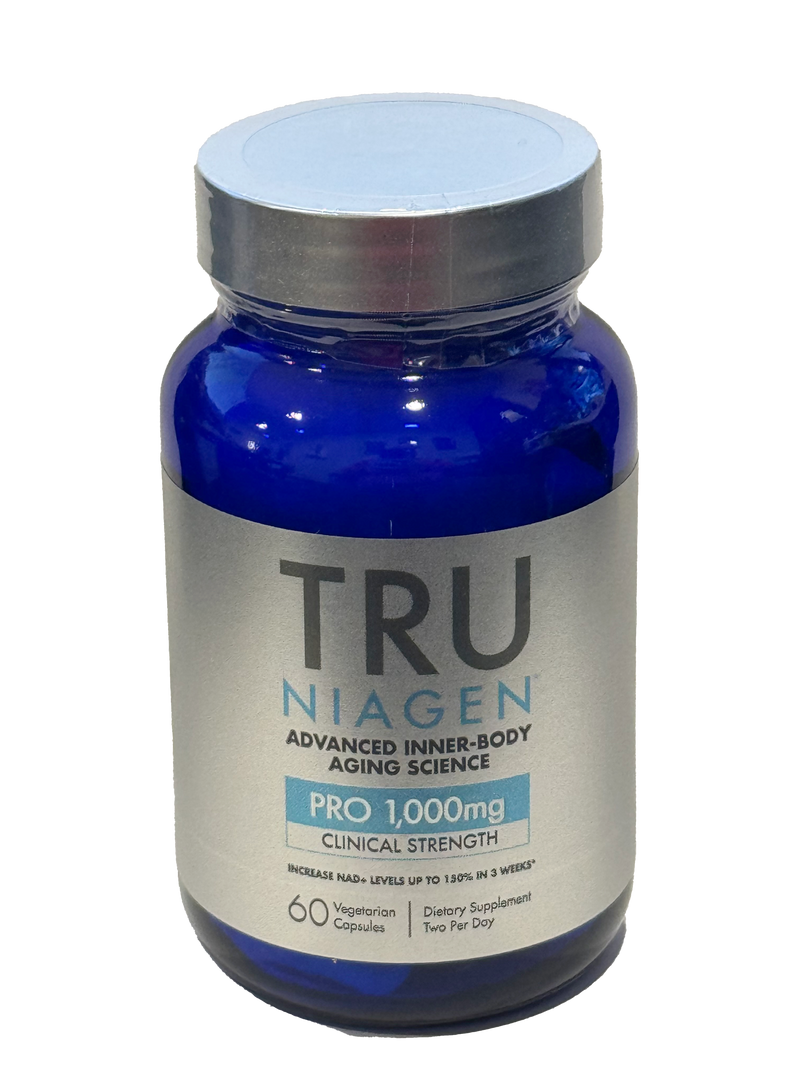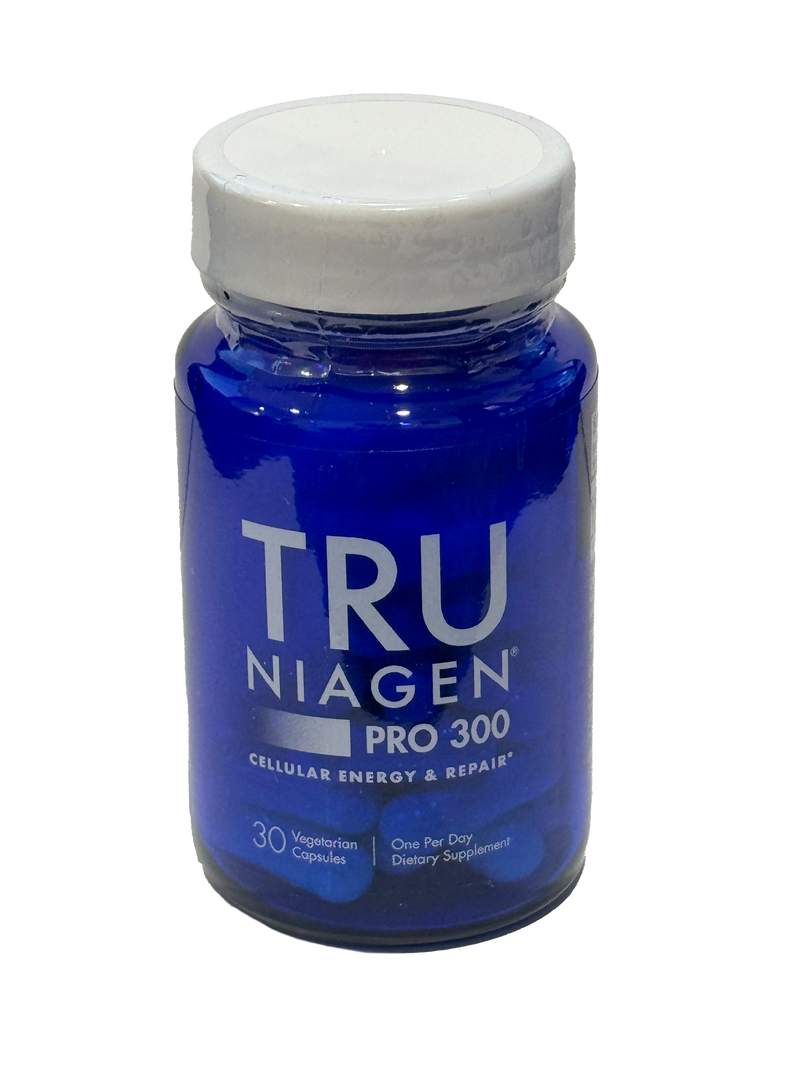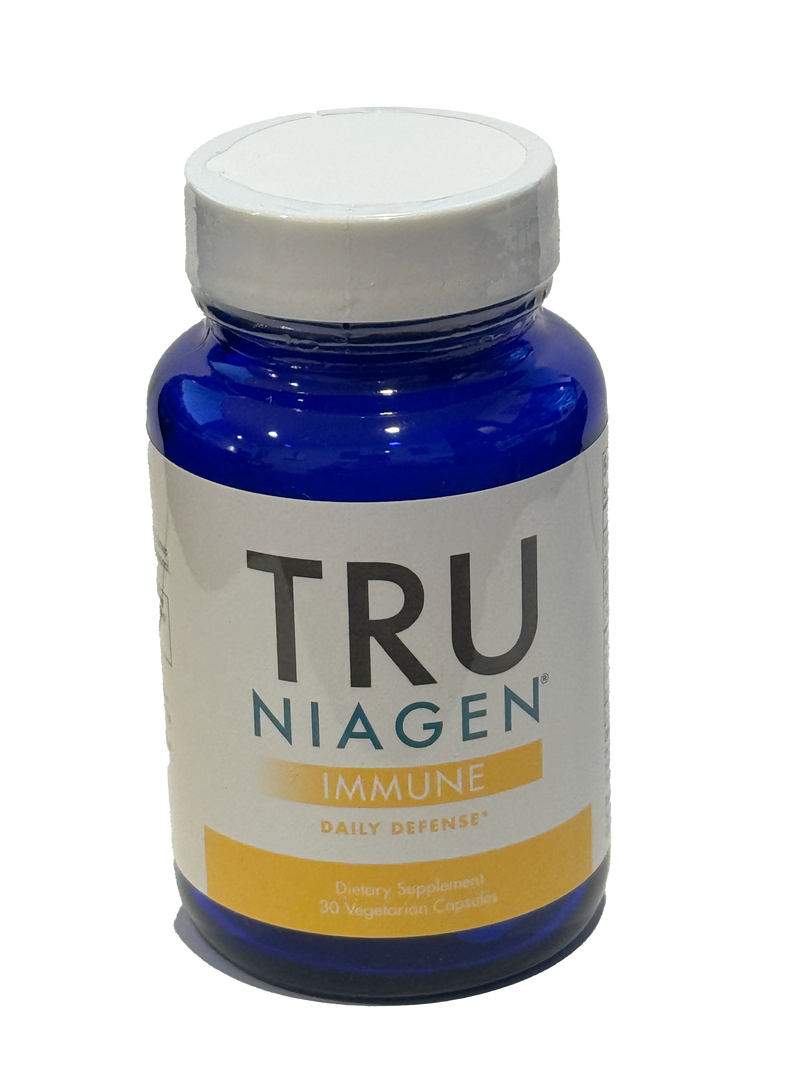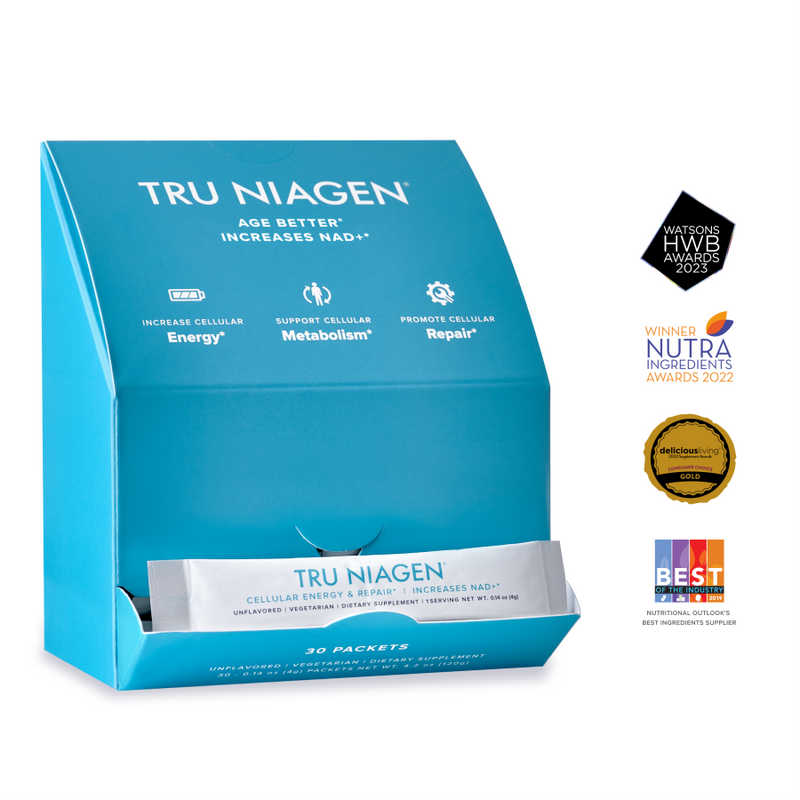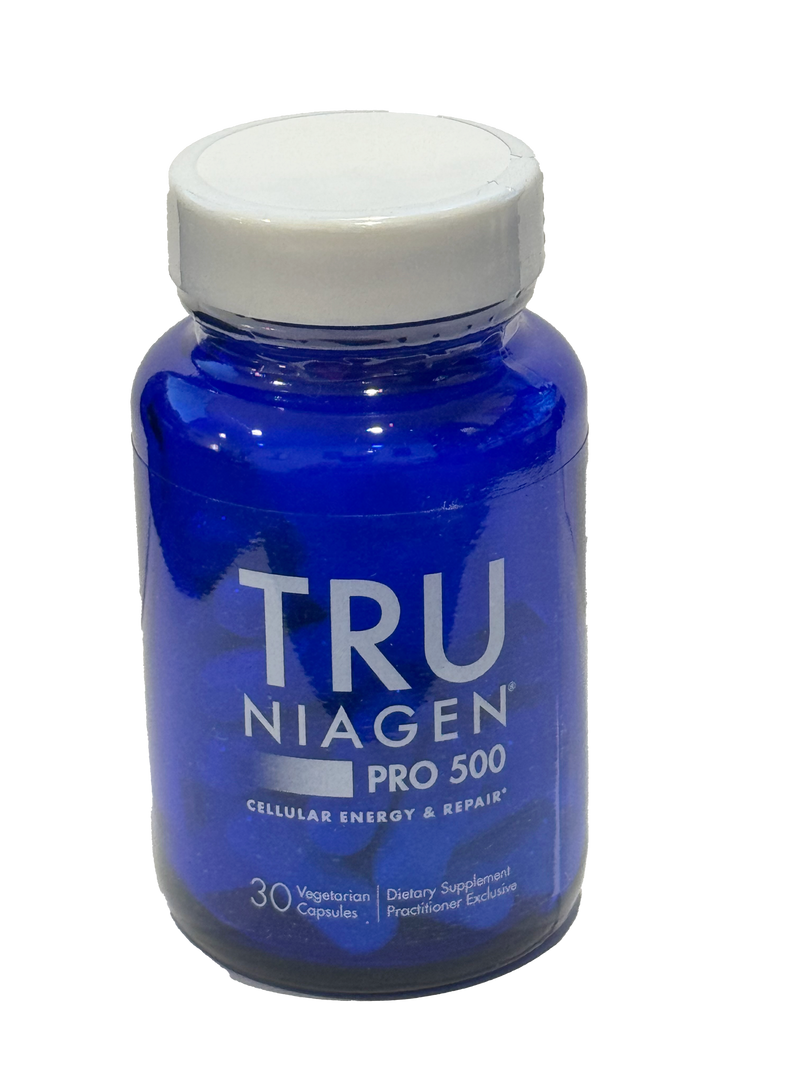
You’re about to discover one of the most innovative, well-researched supplements on the market today.
Supported by decades of extraordinary science, Tru Niagen® is designed to change the way you age by tackling aging at its root.
It all starts deep within your 37.2 trillion cells, with a miraculous molecule called NAD+ (nicotinamide adenine dinucleotide).
Nicotinamide riboside is a groundbreaking ingredient that fuels your body from within.
Your health starts with your cells. Everything you do in life depends on the constant cycle of using and regenerating energy throughout your cells. Scientists have known for decades the importance of a coenzyme (a molecule that binds with proteins) called NAD+ (nicotinamide adenine dinucleotide) plays a vital role in the processes of your body. NAD+ helps create cellular energy and support cellular repair throughout your trillions of cells—and organs—throughout your body.
Your NAD+ supply declines with age as well as in response to stressors on your body including alcohol consumption, intense exercise, and lack of sleep. However, in 2004, Dr. Charles Brenner discovered a naturally-occurring vitamin in milk called nicotinamide riboside. This micronutrient increases NAD+ levels by 40-50%.
While nicotinamide riboside can be found naturally in certain foods, you cannot get anywhere near the amount you need through a normal diet to effectively increase NAD+. That is why we created Tru Niagen®, the only patented, broadly studied, and safety-reviewed nicotinamide riboside in the world. Niagen® has achieved regulatory acceptance for use in supplements by the US FDA. In addition to receiving approval for use in medical foods by the Brazilian Health Regulatory Agency (ANVISA), Niagen® has also been approved for use in food supplements by the European Commission, complementary medicines by the Therapeutic Goods Administration of Australia (TGA), and medical foods by the Food Standards Australia New Zealand (FSANZ). Tru Niagen® has also been approved by Health Canada as a Natural Health Product.
Niagen® is backed by 25 clinical studies that demonstrate safety and/or efficacy.
What Is NAD+?
NAD+ is an acronym for nicotinamide adenine dinucleotide, a coenzyme vital to the many biological processes carried out by every living cell. A coenzyme is a molecule that works with an enzyme to speed up a specific chemical reaction. You have thousands of enzymes in your body, each working as a catalyst for a different biological function. NAD+ is required for over 500 enzymatic reactions and plays key roles in the regulation of almost all major biological processes.
A Brief History of NAD+
Scientists first discovered NAD+ in 1906 when studying fermentation. William John Young and Arthur Harden noticed there was something in liquid extracted from brewing yeast that could boost the fermentation of sugar into alcohol. They called it a “coferment.” Today, it’s called NAD+. Harden kept exploring the science of fermentation and partnered with Hans von Euler-Chelpin to investigate further. In 1929, they won the Nobel Prize for their research and increased understanding of the fermentation process, which included the chemical structure and properties of NAD+. In 1930, Otto Warburg discovered that NAD+ played a role in numerous biochemical reactions in the body. Warburg found that NAD+ was important in the transfer of electrons from one molecule to another. This transfer is the basis for the energy required for all biochemical reactions in the body.
Despite these advances, NAD+ did not receive much public fanfare until the late 1930s, when the NAD+ precursor niacin played a role in treating pellagra, a fatal disease in the American South. Pellagra caused inflamed skin, diarrhea, dementia, and sores in the mouth. Scientists discovered that milk and yeast alleviated pellagra symptoms because they each contain NAD+ precursors. Over time, scientists identified several NAD+ precursors — including nicotinic acid (NA), nicotinamide (NAM), and nicotinamide riboside (NR), which are all essentially different roads that lead to NAD+ production.
How Is NAD+ Important to Energy Production?
Enzymes work in tandem with NAD+ to help produce the body’s energy within your cells’ mitochondria. Mitochondria are nicknamed “the powerhouses of the cell” because they produce energy for all your cellular functions. In fact, 90% of your body’s energy is made within your mitochondria. There are several ways your cells and mitochondria produce energy, and the most efficient way is the electron transport chain process. NAD+ temporarily binds with mitochondrial enzymes, and when the bond breaks, NAD+ transfers electrons with the enzymes. These electrons help catalyze a chemical reaction, triggering the production of cellular energy. It’s called a “chain” because multiple enzymes work together like an assembly line, passing the electrons down to the following enzyme. NAD+ drives this process by acting as a delivery mechanism, providing and accepting negatively charged electrons to and from many enzymes that sit in the mitochondrial membrane. NAD+ ignites these mitochondrial power plants in your body, and without it, the electron transport chain would not start—the assembly line would halt.
Does NAD+ Help Cellular Repair?
In addition to energy production, NAD+ also powers cell regulation and DNA repair by playing the coenzyme role with sirtuins and poly (ADP-ribose) polymerase (PARPs) enzymes. Overeating, excess alcohol consumption, sleep disruption, or lack of exercise can all damage your cells. Sirtuins and PARPs are vital to repairing cellular damage, and NAD+ is the coenzyme that drives this cellular restoration.
Sirtuins manage fat and glucose metabolism in response to physiological changes in energy levels, regulating the network that controls energy homeostasis. Sirtuins also keep chromosomes stable, repair damaged DNA, and reduce cellular stress.
PARPs also play key roles in DNA repair and chromosomal stability. PARPs initiate responses to DNA breaks from harmful metabolic conditions, chemicals, or radiation. Once PARPs detect a DNA breakage, they bind to DNA and begin the synthesis of a new chain of DNA with the help of other DNA-repairing enzymes. PARPs require NAD+ to generate the new DNA strands.
NAD+ depletion is associated with human skin aging, and in animal studies, a NAD+ deficiency increased the sensitivity to ultraviolet (UV) rays and impaired the ability to repair skin cells after sun damage.
Does NAD+ Influence Brain Function?
Your brain is packed with roughly 86 billion neurons, which are responsible for sending and receiving neurotransmitters—chemicals that carry information between brain cells. Neurons are called “excitable cells” because they can become electrically excited in order to produce an impulse—a tiny electrical current. Neurons require large amounts of energy to support their survival and various functions, and as a result, they are susceptible to energy depletion called “excitotoxicity.” Not only have NAD+ levels been identified as critical for neuronal survival, but as stated earlier, NAD+ powers the mitochondria that generate your body’s energy—the same energy that the neurons in your brain neurons need to operate effectively.
Does NAD+ Help the Heart?
Research suggests that maintaining healthy NAD+ levels may help protect the health of the cardiovascular system. A pilot study funded in part by the American Heart Association looked at the health of mitochondria in the heart after supplementation with the NAD+ precursor nicotinamide riboside (NR). The study analyzed peripheral blood mononuclear cells, or PBMCs (white blood cells). The study showed the mitochondrial respiration rate of PBMCs improved following nicotinamide riboside supplementation for five to nine days.
Does Food Contain NAD+?
Foods like broccoli, cabbage, poultry, beef, rice, and milk contain small amounts of the NAD+ precursors tryptophan and niacin (vitamin B3). The amino acid tryptophan yields NAD+, but requires excessively more biosynthetic steps for NAD+ production than the different forms of vitamin B3, thus rendering this amino acid an estimated 60 times less efficient for NAD+ production compared to niacin. Research also indicates that NAD+ levels decrease by up to 65% between age 30 and 70, so food alone won’t compensate for the NAD+ decline with age.

